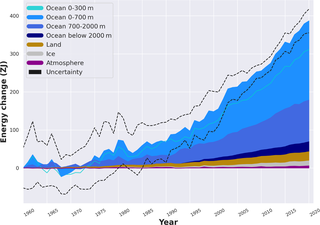Climate inertia

Climate inertia or climate change inertia is the phenomenon by which a planet's
Increasing
Earth's inertial responses are important because they provide the planet's diversity of life and its human civilization further time to adapt to an acceptable degree of planetary change. However, unadaptable change like that accompanying some tipping points may only be avoidable with early understanding and mitigation of the risk of such dangerous outcomes.[7][8] This is because inertia also delays much surface warming unless and until action is taken to rapidly reduce emissions.[9][10] An aim of Integrated assessment modelling, summarized for example as Shared Socioeconomic Pathways (SSP), is to explore Earth system risks that accompany large inertia and uncertainty in the trajectory of human drivers of change.[11]
Inertial timescales
| Earth System Component |
Time Constant (years) |
Response Modes |
|---|---|---|
| Atmosphere | ||
| Water Vapor and Clouds |
10−2-10 | EC, WC |
| Trace Gases | 10−1-108 | CC |
| Hydrosphere | ||
| Ocean Mixed Layer |
10−1-10 | EC, WC, CC |
| Deep Ocean | 10-103 | EC, CC |
| Lithosphere | ||
| Land Surface and Soils |
10−1-102 | EC, WC, CC |
| Subterranean Sediments |
104-109 | CC |
| Cryosphere | ||
| Glaciers | 10−1-10 | EC, WC |
| Sea Ice | 10−1-10 | EC, WC |
| Ice Sheets | 103-106 | EC, WC |
| Biosphere | ||
| Upper Marine | 10−1-102 | CC |
| Terrestrial | 10−1-102 | WC, CC |
| EC=Energy Cycle WC=Water Cycle CC=Carbon Cycle | ||
The
"
Inertial time constants indicate a base rate for forced changes, but lengthy values provide no guarantee of long-term system evolution along a smooth pathway. Numerous higher-order tipping elements having various trigger thresholds and transition timescales have been identified within Earth's present state.[18][19] Such events might precipitate a nonlinear rearrangement of internal energy flows along with more rapid shifts in climate and/or other systems at regional to global scale.[13]: 10–15, 73–76
Climate response time
The response of global surface temperature (GST) to a step-like doubling of the atmospheric CO2 concentration, and its resultant forcing, is defined as the Equilibrium Climate Sensitivity (ECS). The ECS response extends over short and long timescales, however the main time constant associated with ECS has been identified by Jule Charney, James Hansen and others as a useful metric to help guide policymaking.[10][20] RCPs, SSPs, and other similar scenarios have also been used by researchers to simulate the rate of forced climate changes. By definition, ECS presumes that ongoing emissions will offset the ocean and land carbon sinks following the step-wise perturbation in atmospheric CO2.[10][21]
ECS response time is proportional to ECS and is principally regulated by the thermal inertia of the uppermost
Components
This section needs expansion. You can help by adding to it. (February 2023) |
Thermal inertia

Thermal inertia is a term which refers to the observed delays in a body's temperature response during heat transfers. A body with large thermal inertia can store a big amount of energy because of its
Ocean inertia
The global ocean is Earth's largest
Ice sheet inertia
Even after
Permafrost also takes longer to respond to a warming planet because of thermal inertia, due to ice rich materials and permafrost thickness.[26]
Inertia from carbon cycle feedbacks

Earth's carbon cycle feedback includes a destabilizing positive feedback (identified as the climate-carbon feedback) which prolongs warming for centuries, and a stabilizing negative feedback (identified as the concentration-carbon feedback) which limits the ultimate warming response to fossil carbon emissions. The near-term effect following emissions is asymmetric with latter mechanism being about four times larger,[5][28] and results in a significant net slowing contribution to the inertia of the climate system during the first few decades following emissions.[9]
Ecological inertia
Depending on the ecosystem, effects of climate change could show quickly, while others take more time to respond. For instance, coral bleaching can occur in a single warm season, while trees may be able to persist for decades under a changing climate, but be unable to regenerate. Changes in the frequency of extreme weather events could disrupt ecosystems as a consequence, depending on individual response times of species.[25]
Policy implications of inertia
The IPCC concluded that the inertia and uncertainty of the climate system, ecosystems, and socioeconomic systems implies that margins for safety should be considered. Thus, setting strategies, targets, and time tables for avoiding dangerous interference through climate change. Further the IPCC concluded in their 2001 report that the stabilization of atmospheric CO2 concentration, temperature, or sea level is affected by:[25]
- The inertia of the climate system, which will cause climate change to continue for a period after mitigation actions are implemented.[8][29]
- Uncertainty regarding the location of possible thresholds of irreversible change and the behavior of the system in their vicinity.
- The time lags between adoption of mitigation goals and their achievement.
See also
References
- ^ "Explainer: How 'Shared Socioeconomic Pathways' explore future climate change". Carbon Brief. 19 April 2018. Retrieved 14 February 2023.
- ISSN 0959-3780.
- ^ a b Michon Scott (2006-04-24). "Earth's Big Heat Bucket". NASA Earth Observatory.
- ^ S2CID 54695479.
- ^ .
- ISBN 9781009157896.
- ^ PMID 24312568.
- ^ PMID 24101485.
- ^ S2CID 44352274.
- ^ .
- ISSN 1750-6816.
- ^ ISBN 978-2271057327.
- ^ ISBN 978-0-309-13304-3.
- S2CID 29665980.
- PMID 30082409.
- ^ S2CID 22938919.
- ISBN 978-90-277-2789-3.
- PMID 18258748.
- S2CID 252161375.
- doi:10.17226/12181.
- PMID 33015673.
- .
- .
- arXiv:1307.6821 [physics.ao-ph].
- ^ a b c "Climate Change 2001: Synthesis Report". IPCC. 2001. Retrieved 11 May 2015.
- CiteSeerX 10.1.1.383.5875.
- .
- hdl:2268/12933.
- PMID 32636367.
